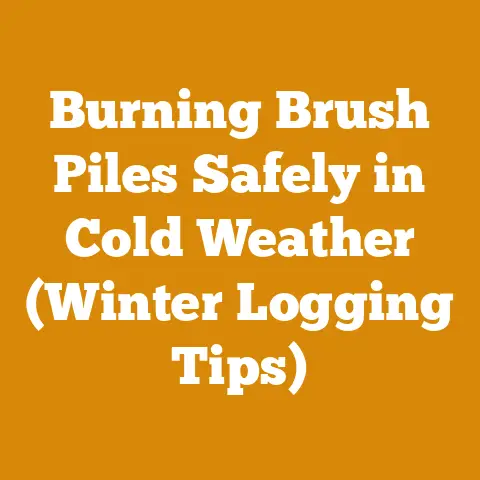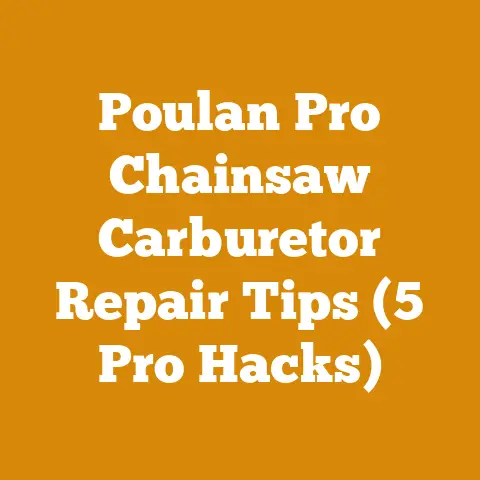MS180 Stihl Chain Guide (5 Expert Tips for Optimal Cutting)
Alright, folks, gather ’round the virtual campfire! Today, we’re diving headfirst into the wonderful world of the MS180 Stihl chainsaw – a real workhorse, I tell ya. Now, I know what you’re thinking: “Another chainsaw guide? Yawn.” But trust me, this ain’t your grandpa’s instruction manual. I’m going to give you 5 expert tips to make your MS180 sing like a finely tuned bluegrass banjo. We’re talking optimal cutting, maximum efficiency, and maybe even a little chainsaw swagger. So, grab your safety glasses (safety first, always!), and let’s get started.
MS180 Stihl Chain Guide: 5 Expert Tips for Optimal Cutting
The MS180 Stihl chainsaw is a popular choice for homeowners and light-duty users. It’s lightweight, easy to handle, and relatively inexpensive. However, like any tool, it performs best when properly maintained and used correctly. I’ve spent countless hours in the woods with my MS180, and I’ve learned a few tricks along the way. These tips will help you get the most out of your MS180 and ensure safe, efficient cutting.
Tip 1: Mastering Chain Tension – The Goldilocks Principle
Chain tension is absolutely critical for optimal cutting and safety. Too loose, and the chain can derail, causing serious injury. Too tight, and you’ll wear out the bar, chain, and even the saw’s engine. Finding that “just right” tension is key.
Why Chain Tension Matters
- Safety: A loose chain is a dangerous chain. It can jump off the bar and cause injury.
- Performance: A properly tensioned chain cuts smoothly and efficiently. A loose chain will vibrate and “chatter,” reducing cutting speed. A tight chain will bind and overheat.
- Longevity: Correct tension extends the life of the bar, chain, and saw.
The “Pull and Snap” Method
Here’s my go-to method for checking chain tension:
- Loosen the bar nuts: Just enough so you can adjust the tension.
- Lift the chain: Using a gloved hand (always!), lift the chain in the middle of the bar.
- Check the gap: You should be able to pull the chain away from the bar about the thickness of a dime (approximately 1.5mm).
- Tighten the tensioning screw: Turn the screw until the chain reaches the correct tension.
- Tighten the bar nuts: Securely tighten the bar nuts.
Pro Tip: Check chain tension frequently, especially when the chain is new. A new chain will stretch more initially.
The Hot Chain Adjustment
When the chain heats up from use, it expands. This can cause the chain to become too tight. If you’re cutting for an extended period, stop occasionally and check the tension. You may need to loosen it slightly.
Personal Story: I once ignored a tightening chain while felling a small tree. The chain bound up so tight it stalled the saw and nearly threw me off balance. Lesson learned: pay attention to chain tension!
Common Mistakes to Avoid
- Over-tightening: This is a common mistake. A chain that’s too tight will bind and cause excessive wear.
- Ignoring tension changes: Chain tension changes as the chain heats up and cools down. Check it regularly.
- Using the wrong tools: Always use the correct wrench for tightening the bar nuts.
Takeaway: Proper chain tension is crucial for safety, performance, and longevity. Use the “pull and snap” method and check tension frequently.
Tip 2: Sharpening Skills – Turning Dull into Deadly
A sharp chain is a safe chain. A dull chain requires more force to cut, increasing the risk of kickback and operator fatigue. Plus, a sharp chain cuts faster and more efficiently. I can’t stress this enough: learn to sharpen your own chain.
Why Sharpening Matters
- Safety: A sharp chain reduces the risk of kickback.
- Performance: A sharp chain cuts faster and more efficiently.
- Reduced Fatigue: A sharp chain requires less effort to operate, reducing fatigue.
- Cost Savings: Sharpening your own chain saves money on professional sharpening services.
The Hand Filing Method
This is my preferred method for sharpening chains. It takes practice, but it’s the most precise way to maintain your chain.
- Secure the saw: Use a vise to hold the saw securely.
- Use the correct file: Use a round file that matches the chain’s pitch (usually 5/32″ for the MS180).
- Use a filing guide: A filing guide helps maintain the correct angle and depth.
- File each cutter: File each cutter with smooth, even strokes. Follow the manufacturer’s recommendations for filing angle and depth.
- Check the depth gauges: Use a depth gauge tool to ensure the depth gauges are at the correct height.
- Lower the depth gauges: File the depth gauges with a flat file if they are too high.
Detailed Steps:
- Securing the Saw: The saw must be stable. I use a small portable vise that clamps onto the bar. This allows me to sharpen the chain right in the field.
- Choosing the Right File: Using the wrong size file will ruin the chain. Consult your owner’s manual for the correct size.
- Filing Angle and Depth: Most chains have markings on the cutters that indicate the correct filing angle. Follow these markings carefully.
- Depth Gauges: These small “rakers” in front of each cutter control how deeply the cutter bites into the wood. If they are too high, the chain won’t cut effectively.
The Electric Chain Sharpener Method
Electric chain sharpeners are faster and easier to use than hand filing. However, they can also be more aggressive and remove more material.
- Mount the sharpener: Securely mount the sharpener on a workbench.
- Adjust the settings: Adjust the settings to match the chain’s pitch and angle.
- Sharpen each cutter: Sharpen each cutter according to the manufacturer’s instructions.
- Check the depth gauges: Check the depth gauges and file them if necessary.
Pro Tip: Use light pressure when using an electric sharpener. Too much pressure can overheat the chain and damage the cutters.
When to Sharpen
- When the chain starts to cut slowly: This is the most obvious sign.
- When the chain produces sawdust instead of chips: A sharp chain produces long, thin chips.
- After hitting dirt or rocks: Even a brief encounter with dirt or rocks can dull the chain.
- Before each major cutting project: It’s always best to start with a sharp chain.
Personal Story: I once spent an entire day struggling to cut firewood with a dull chain. I was exhausted and frustrated. Finally, I took the time to sharpen the chain, and the difference was night and day. I could have saved myself a lot of time and effort if I had just sharpened the chain in the first place.
Common Mistakes to Avoid
- Using the wrong file: This can damage the chain.
- Filing at the wrong angle: This will reduce the chain’s cutting efficiency.
- Ignoring the depth gauges: This will prevent the chain from cutting properly.
- Over-sharpening: This will weaken the chain.
Takeaway: Sharpening your chain is essential for safety, performance, and efficiency. Learn to sharpen your own chain and sharpen it frequently.
Tip 3: Bar and Chain Maintenance – The Dynamic Duo
The bar and chain work together as a team. Proper maintenance of both is essential for optimal cutting.
Bar Maintenance
The bar guides the chain and supports it during cutting. Here’s how to keep your bar in top condition:
- Clean the bar: Remove sawdust and debris from the bar regularly.
- Check the bar rails: The bar rails should be smooth and even. Use a bar rail dressing tool to remove any burrs or unevenness.
- Lubricate the bar: Use bar and chain oil to lubricate the bar and chain.
- Flip the bar: Flip the bar regularly to even out wear.
- Check the oiler: Make sure the oiler is working properly. The chain should be lightly coated with oil during cutting.
Detailed Steps:
- Cleaning the Bar: I use a wire brush to remove sawdust and debris. Pay particular attention to the oil holes.
- Checking the Bar Rails: Run your finger along the bar rails. If you feel any burrs or unevenness, use a bar rail dressing tool to smooth them out.
- Lubricating the Bar: Bar and chain oil reduces friction and wear. Use a high-quality oil specifically designed for chainsaws.
- Flipping the Bar: This helps to distribute wear evenly. I flip the bar every time I sharpen the chain.
- Checking the Oiler: The oiler should be adjusted to deliver a steady stream of oil to the chain. You should see a light coating of oil on the chain after cutting.
Chain Maintenance
The chain is the cutting tool. Here’s how to keep your chain in top condition:
- Sharpen the chain: As discussed in Tip 2.
- Clean the chain: Remove sawdust and debris from the chain regularly.
- Lubricate the chain: Use bar and chain oil to lubricate the chain.
- Check for damage: Inspect the chain for any signs of damage, such as cracked or broken cutters.
- Replace the chain: Replace the chain when it is worn or damaged.
Pro Tip: Use a chain breaker and spinner to repair damaged chains. This can save you money on replacement chains.
Common Mistakes to Avoid
- Neglecting bar lubrication: This will cause excessive wear on the bar and chain.
- Using the wrong oil: Use only bar and chain oil. Other types of oil can damage the bar and chain.
- Ignoring bar rail damage: This can cause the chain to bind and derail.
- Running a damaged chain: This is dangerous and can damage the saw.
Personal Story: I once ran my MS180 without enough bar oil. The bar overheated and warped, and the chain was ruined. It was a costly mistake that could have been avoided with proper maintenance.
Takeaway: Regular bar and chain maintenance is essential for optimal cutting and longevity. Clean, lubricate, and inspect both components regularly.
Tip 4: Fuel and Air – The Breath of Life
The MS180 is a two-stroke engine, which means it requires a mixture of gasoline and oil. Using the correct fuel and air filter is crucial for performance and engine life.
Fuel
- Use the correct fuel: Use unleaded gasoline with an octane rating of 89 or higher.
- Mix the fuel and oil: Use a high-quality two-stroke oil at the correct ratio (usually 50:1).
- Use fresh fuel: Gasoline can degrade over time. Use fresh fuel (less than 30 days old).
- Store fuel properly: Store fuel in a sealed container in a cool, dry place.
Detailed Steps:
- Mixing Fuel and Oil: Always use the correct ratio. Too much oil can foul the spark plug, and too little oil can damage the engine. I use a pre-measured mixing bottle to ensure the correct ratio.
- Using Fresh Fuel: Old fuel can cause starting problems and reduce performance. I always label my fuel containers with the date.
- Storing Fuel Properly: Store fuel away from direct sunlight and heat.
Air Filter
- Clean the air filter: Clean the air filter regularly. A dirty air filter restricts airflow and reduces performance.
- Replace the air filter: Replace the air filter when it is damaged or excessively dirty.
Pro Tip: Use compressed air to clean the air filter. Blow the dirt out from the inside out.
Common Mistakes to Avoid
- Using the wrong fuel: This can damage the engine.
- Using old fuel: This can cause starting problems and reduce performance.
- Neglecting the air filter: This can reduce performance and damage the engine.
- Over-oiling the air filter: This can restrict airflow.
Personal Story: I once tried to start my MS180 after it had been sitting for several months. It wouldn’t start. I eventually realized that the fuel had gone bad. I drained the old fuel and replaced it with fresh fuel, and the saw started right up.
Takeaway: Use the correct fuel and maintain the air filter for optimal performance and engine life.
Tip 5: Safe Cutting Techniques – Respect the Beast
Chainsaws are powerful tools that can be dangerous if not used properly. Always follow safe cutting techniques.
Personal Protective Equipment (PPE)
- Wear safety glasses: Protect your eyes from flying debris.
- Wear hearing protection: Chainsaws are loud. Protect your hearing.
- Wear gloves: Protect your hands from cuts and abrasions.
- Wear chainsaw chaps: Protect your legs from cuts.
- Wear steel-toed boots: Protect your feet from falling logs.
- Wear a helmet: Protect your head from falling branches.
Detailed Explanation:
- Safety Glasses: Choose safety glasses that meet ANSI standards.
- Hearing Protection: Use earplugs or earmuffs with a noise reduction rating (NRR) of at least 25 decibels.
- Chainsaw Chaps: These are essential for protecting your legs. They are made of ballistic nylon that can stop a chainsaw chain.
- Steel-Toed Boots: Choose boots that provide ankle support and have a non-slip sole.
- Helmet: A helmet can protect you from falling branches and other hazards.
Safe Cutting Practices
- Keep a firm grip: Use both hands to grip the saw firmly.
- Maintain a stable stance: Keep your feet firmly planted on the ground.
- Be aware of your surroundings: Watch out for obstacles and other people.
- Avoid cutting above your head: This is dangerous and can lead to loss of control.
- Use the correct cutting technique: Use the correct cutting technique for the type of cut you are making.
- Be aware of kickback: Kickback is a sudden, violent reaction that can occur when the chain is pinched or snagged.
- Never cut with the tip of the bar: The tip of the bar is the most likely area to cause kickback.
- Stop the saw before moving: Always stop the saw before moving to a new location.
- Never operate a chainsaw when you are tired or under the influence of drugs or alcohol: This is extremely dangerous.
Pro Tip: Take a chainsaw safety course. These courses teach you how to use a chainsaw safely and effectively.
Understanding Kickback
Kickback is the most common cause of chainsaw injuries. It occurs when the chain is pinched or snagged, causing the saw to kick back towards the operator.
- Rotational Kickback: Occurs when the upper quadrant of the bar nose contacts a solid object or is pinched. The saw kicks back in an upward arc towards the operator.
- Pinch Kickback: Occurs when the wood closes in and pinches the chain in the cut. The saw can be forced back towards the operator.
- Pull-In: Occurs when the bottom of the bar nose is used to cut and the chain catches on a solid object. The saw is pulled away from the operator.
Personal Story: I was once cutting a small tree when the chain pinched in the cut. The saw kicked back violently, and I narrowly avoided being struck by the chain. I learned a valuable lesson that day: always be aware of the potential for kickback.
Common Mistakes to Avoid
- Not wearing PPE: This is the most common mistake.
- Cutting above your head: This is dangerous and can lead to loss of control.
- Cutting with the tip of the bar: This is the most likely area to cause kickback.
- Operating a chainsaw when you are tired or under the influence of drugs or alcohol: This is extremely dangerous.
Takeaway: Always follow safe cutting techniques. Wear PPE, be aware of your surroundings, and avoid kickback.
Bonus Tip: Storage – A Place for Everything
Proper storage is essential for extending the life of your MS180.
- Clean the saw: Clean the saw thoroughly after each use.
- Drain the fuel: Drain the fuel tank before storing the saw for an extended period.
- Remove the chain: Remove the chain and clean it.
- Store the saw in a dry place: Store the saw in a dry place to prevent rust and corrosion.
- Use a carrying case: Use a carrying case to protect the saw from damage.
Why this matters:
- Prevents Corrosion: Moisture can cause rust and corrosion, damaging the saw’s components.
- Protects Components: A carrying case protects the saw from physical damage during storage and transport.
- Extends Lifespan: Proper storage significantly extends the life of your MS180.
Personal anecdote: I once left my chainsaw outside in the rain. When I went to use it a few weeks later, the chain was rusted and the engine wouldn’t start. I had to spend a lot of time and money repairing the saw.
Final Thoughts:
The MS180 Stihl chainsaw is a reliable and versatile tool. By following these 5 expert tips, you can ensure optimal cutting, extend the life of your saw, and stay safe while working. Remember, safety first, always! Now get out there and make some sawdust!






